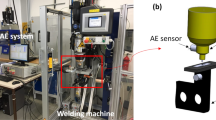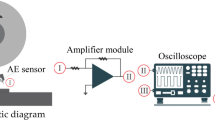Abstract
Galling wear in sheet metal stamping processes can degrade the product quality and adversely affect mass production. Studies have shown that acoustic emission (AE) sensors can be used to measure galling. In the literature, attempts have been made to correlate the AE features and galling wear in the sheet metal stamping process. However, there is very little attempt made to implement machine learning (ML) techniques to detect AE features that can classify non-galling and galling wear as well as provide additional wear-state information in the form of strong visualisations. In the first part of the paper, time domain and frequency domain analysis is used to determine the AE features that can be used for unsupervised classification. Due to galling wear progression on the stamping tools, the behaviour of AE waveform changes from stationary to a non-stationary state. The initial change in AE waveform behaviour due to galling wear initiation is very difficult to observe due to the ratio of change against the large data size of the waveform. Therefore, a time-frequency technique “Hilbert Huang transform” is applied to the AE waveform as that is sensitive to change of wear state and is used for the classification of “non-galling” and the “transition of galling.” Also, the unsupervised learning algorithm fuzzy clustering is used as comparison against the supervised learning techniques. Despite not knowing a priori the wear-state labels, fuzzy clustering is able to define three relatively accurate distinct classes: “unworn”, “transition to galling” and “severe galling”. In the second part of the paper, the AE features are used as an input to the supervised ML algorithms to classify AE features related to non-galling and galling wear. An accuracy of 96% was observed for the prediction of non-galling and galling wear using classification, regression tree (CART) and neural network techniques. In the last part, a reduced short time Fourier transform of top 10 absolute maximum component AE feature sets that correlates to wear measurement data “profile depth” is used to train and test supervised neural network and CART algorithms. The algorithms predicted the profile depth of 530 unseen parts (530 unseen cases), which did not have any associated labelled depth data. This shows the power of using ML techniques that can use a small data training set to provide additional predicted wear state on a much larger data set. Furthermore, the ML techniques presented in this paper can be used further to develop a real-time measurement system to detect the transition of galling wear from measured AE features.













Similar content being viewed by others
References
B. Lu and X. Zhou, “Quality and reliability oriented maintenance for multistage manufacturing systems subject to condition monitoring,” J Manuf Syst, vol. 2019, no. Part A, pp. 76–85.
Dong Q, Kontar R, Min L, Gang X, Xu J (2019) A simple approach to multivariate monitoring of production processes with non-Gaussian data. J Manuf Syst 53:291–304
Paolanti M, Romeo L, Felicetti A, Mancini A, Frontoni E, Loncarski J Machine learning approach for predictive maintenance in industry 4.0. 2018 14th IEEE/ASME Int Conf Mechatron Embed Syst Appl:1–6
D.-H. Lee, J.-K. Yang, L. Cho-Heui, and K.-J. Kim, “A data-driven approach to selection of critical process steps in the semiconductor manufacturing process considering missing and imbalanced data,” J Manuf Syst, vol. 52, no. Part A, pp. 146–156, 2019.
Ubhayaratne I, Pereira MP, Xiang Y, Rolfe BF (2017) Audio signal analysis for tool wear monitoring in sheet metal stamping. Mech Syst Signal Process. https://doi.org/10.1016/j.ymssp.2016.09.014
Xu Y, Ge M (2004) Hidden Markov model-based process monitoring system. J Intell Manuf. https://doi.org/10.1023/B:JIMS.0000026572.03164.64
Bassiuny AM, Li X, Du R (2007) Fault diagnosis of stamping process based on empirical mode decomposition and learning vector quantization. Int J Mach Tools Manuf. https://doi.org/10.1016/j.ijmachtools.2007.06.006
Ge M, Du R, Zhang G, Xu Y (2004) Fault diagnosis using support vector machine with an application in sheet metal stamping operations. Mech Syst Signal Process. https://doi.org/10.1016/S0888-3270(03)00071-2
Cervantes J, Garcia-Lamont F, Rodriguez-Mazahua L, Lopez A (2020) A comprehensive survey on support vector machine classification: applications, challenges and trends. Neurocomputing 408:189–215
García C (2005) Artificial intelligence applied to automatic supervision, diagnosis and control in sheet metal stamping processes. J Mater Process Technol. https://doi.org/10.1016/j.jmatprotec.2005.02.031
Li W, Zhang L, Chen X, Wu C, Cui Z, Niu C (2020) Predicting the evolution of sheet metal surface scratching by the technique of artificial intelligence. Int J Adv Manuf Technol:1–13. https://doi.org/10.1007/s00170-020-06394-4
Li X (2002) A brief review: acoustic emission method for tool wear monitoring during turning. Int J Mach Tools Manuf. https://doi.org/10.1016/S0890-6955(01)00108-0
Sick B (2002) On-line and indirect tool wear monitoring in turning with artificial neural networks: a review of more than a decade of research. Mech Syst Signal Process. https://doi.org/10.1006/mssp.2001.1460
G. and S. L., Godin N, Huguet S (2004) Clustering of acoustic emission signals collected during tensile tests on unidirectional glass/polyester composite using supervised and unsupervised classifiers. NDT&E Int 37:253–264
Shanbhag VV, Rolfe BF, Arunachalam N, Pereira MP (2018) Investigating galling wear behaviour in sheet metal stamping using acoustic emissions. Wear. https://doi.org/10.1016/j.wear.2018.07.003
Ren Q, Balazinski M, Jemielniak K, Baron L, Achiche S (2013) Experimental and fuzzy modelling analysis on dynamic cutting force in micro milling. Soft Comput. https://doi.org/10.1007/s00500-013-0983-0
Ren Q, Baron L, Balazinski M (2012) Fuzzy identification of cutting acoustic emission with extended subtractive cluster analysis. Nonlinear Dyn. https://doi.org/10.1007/s11071-011-0173-5
Ren Q, Balazinski M, Baron L, Jemielniak K, Botez R, Achiche S (2014) Type-2 fuzzy tool condition monitoring system based on acoustic emission in micromilling. Inf Sci. https://doi.org/10.1016/j.ins.2013.06.010
Venkatesh K, Zhou M, Caudill RJ (1997) Design of artificial neural networks for tool wear monitoring. J Intell Manuf. https://doi.org/10.1023/A:1018573224739
Griffin J, Chen X (2014) Real-time fuzzy-clustering and CART rules classification of the characteristics of emitted acoustic emission during horizontal single-grit scratch tests. Int J Adv Manuf Technol. https://doi.org/10.1007/s00170-014-5959-4
Shanbhag VV, Rolfe BF, Pereira MP (2020) Investigation of galling wear using acoustic emission frequency characteristics. Lubricants. https://doi.org/10.3390/lubricants8030025
Teymuri Sindi C, Ahmadi Najafabadi M, Salehi M (2013) Tribological behavior of sheet metal forming process using acoustic emission characteristics. Tribol Lett. https://doi.org/10.1007/s11249-013-0193-z
Hase A, Mishina H, Wada M (2012) Correlation between features of acoustic emission signals and mechanical wear mechanisms. Wear. https://doi.org/10.1016/j.wear.2012.05.019
Fan X, Zuo MJ (2006) Gearbox fault detection using Hilbert and wavelet packet transform. Mech Syst Signal Process. https://doi.org/10.1016/j.ymssp.2005.08.032
Yan R, Gao RX (2006) Hilbert-Huang transform-based vibration signal analysis for machine health monitoring. IEEE Trans Instrum Meas. https://doi.org/10.1109/TIM.2006.887042
Hamdi SE, Le Duff A, Simon L, Plantier G, Sourice A, Feuilloy M (2013) Acoustic emission pattern recognition approach based on Hilbert-Huang transform for structural health monitoring in polymer-composite materials. Appl Acoust. https://doi.org/10.1016/j.apacoust.2012.11.018
Pereira MP, Weiss M, Rolfe BF, Hilditch TB (2013) The effect of the die radius profile accuracy on wear in sheet metal stamping. Int J Mach Tools Manuf. https://doi.org/10.1016/j.ijmachtools.2012.11.001
Chen GX, Zhou ZR (2007) Time-frequency analysis of friction-induced vibration under reciprocating sliding conditions. Wear. https://doi.org/10.1016/j.wear.2006.03.055
Tse PW, Chu FL, Peng ZK (2005) A comparison study of improved Hilbert–Huang transform and wavelet transform: application to fault diagnosis for rolling bearing. Mech Syst Signal Process
Yang Z, Yu Z, Xie C, Huang Y (2014) Application of Hilbert-Huang Transform to acoustic emission signal for burn feature extraction in surface grinding process. Meas J Int Meas Confed. https://doi.org/10.1016/j.measurement.2013.08.036
Miller I, Papoulis A (1966) Probability, random variables, and stochastic processes. Technometrics. https://doi.org/10.2307/1266379
Voss BM, Pereira MP, Rolfe BF, Doolan MC (2017) Using stamping punch force variation for the identification of changes in lubrication and wear mechanism. IOP Conf Ser J Phys 896:12028 Available: https://iopscience.iop.org/article/10.1088/1742-6596/896/1/012028/pdf
Strang T (1996) G., Nguyen, Wavelets and filter banks. Wesley, Cambridge
Sathya R, Abraham A (2013) Comparison of supervised and unsupervised learning algorithms for pattern classification. Int J Adv Res Artif Intell. https://doi.org/10.14569/ijarai.2013.020206
Cuevas A, Febrero M, Fraiman R (2001) Cluster analysis: a further approach based on density estimation. Comput Stat Data Anal. https://doi.org/10.1016/S0167-9473(00)00052-9
Gordon AD, Breiman L, Friedman JH, Olshen RA, Stone CJ (1984) Classification and regression trees. Biometrics. https://doi.org/10.2307/2530946
Lawrence RL, Wright A (2001) Rule-based classification systems using classification and regression tree (CART) analysis. Photogramm Eng Remote Sens
Rumelhart DE, Hinton GE, Williams RJ (1986) Learning representations by back-propagating errors. Nature. https://doi.org/10.1038/323533a0
Intanagonwiwat C., “The divide-and-conquer neural network: its architecture and training,” 1998.
Availability of data and materials
Data will be made available on request.
Author information
Authors and Affiliations
Contributions
J.M.G. and V.V.S. conceived of the presented idea. J.M.G developed the theory and performed the computations. J.M.G and B.F.R. verified the analytical methods. B.F.R encouraged J.M.G to investigate divide and conquer method of neural networks with very low data set and supervised the findings of this work. V.V.S. contributed to the flow, style and quality of manuscript. Also, V.V.S. provided the data from experiments. M.P.P. contributed on the materials and mechanical aspects of the work. All authors discussed the results and contributed to the final manuscript.
Corresponding author
Ethics declarations
Ethics approval
Not applicable.
Consent to participate
Not applicable.
Consent for publication
Not applicable.
Competing interests
The authors declare no competing interests.
Additional information
Publisher’s note
Springer Nature remains neutral with regard to jurisdictional claims in published maps and institutional affiliations.
Rights and permissions
About this article
Cite this article
Griffin, J.M., Shanbhag, V.V., Pereira, M.P. et al. Application of machine learning for acoustic emissions waveform to classify galling wear on sheet metal stamping tools. Int J Adv Manuf Technol 116, 579–596 (2021). https://doi.org/10.1007/s00170-021-07408-5
Received:
Accepted:
Published:
Issue Date:
DOI: https://doi.org/10.1007/s00170-021-07408-5




